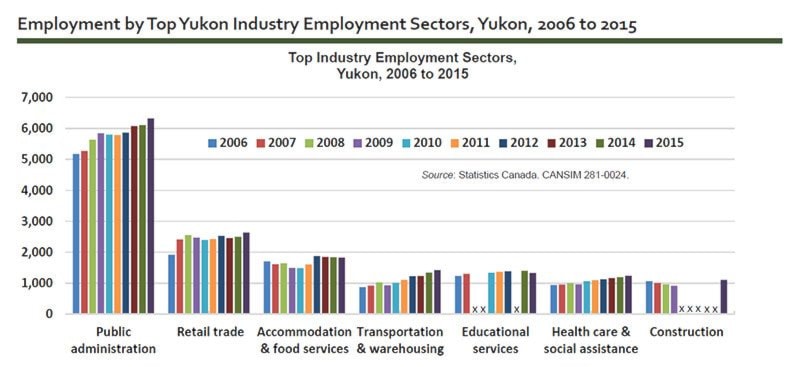Despite all the bad Powerpoint out there, every once in awhile you see a chart that tells the whole story in one glance.
Our data boffins at the Yukon Bureau of Statistics have done just this with figures that show the number of Yukoners employed in each sector of the economy over the last decade. This visual nicely encapsulates Yukon economic trends during the last 10 years.
On the left, you have a huge and rising stack of bars representing public administration, going from around 5,000 in 2006 to over 6,000 in 2015. These are what you or I might call “government jobs,” although they do not include some government workers in other categories like schools or healthcare.
Then you have a bunch of job families that give you a picture of how workers are deployed across our economy. This includes around 2,500 retail jobs, almost 2,000 restaurant and hotel jobs, just over 1,000 educational jobs, similar numbers in the transportation and warehousing category, and around 1,000 jobs in both healthcare and construction.
Most of these job families have been flat over the last decade, or growing a lot slower than public administration. Healthcare has been inching higher, but more slowly than public administration despite our aging population and needs in areas like mental health. Transportation and warehousing has been growing solidly, probably because of the opening of new mines since the chart begins in 2006.
But public administration is both big and growing fast.
Outside analysts at the Frontier Centre for Public Policy and the Atlantic Institute for Market Studies recently created a stir on a similar topic with a study on the size of government in the western provinces. CBC’s headline on the report was, “Manitoba should cut 36,000 civil service jobs, think-tank says.”
Using Statistics Canada data, they reported that the average Canadian province had 83 public sector employees per 1,000 residents. Our nearest neighbours, BC and Alberta, were below this average. Saskatchewan and Manitoba were the highest in Canada, tied at 111.
Although the report didn’t include the territories, I calculated the Yukon’s number. As of the third quarter last year, our population was 38,200. The Yukon Bureau of Statistics reported that we had 8,100 public sector jobs as of January, 2017. This is a different, and broader, definition of government jobs compared to the “public administration” figures above. It includes all people employed by our four levels of government in federal, territorial, First Nations and municipal outfits.
Compared on this basis, we get a figure of 212 Yukon public sector jobs per 1,000 residents, nearly double the provinces with the biggest public sectors.
BC’s figure is 75, suggesting our public sector is three times the size of that province’s as a proportion of the population.
These figures are also interesting if you consider them in the context of the typical political debate in Canada. The left accuses the right of wanting to decimate the public service. The right accuses the left of wanting to stifle economic growth with huge bureaucracies.
Meanwhile, the figures show that Saskatchewan under the right-leaning Saskatchewan Party has more public employees per capita than Quebec, which is often criticized for being “statist.” The Yukon’s surge in public administration jobs shown in the chart above happened under the Fentie and Pasloski administrations.
Differences between provinces are probably better explained by differences in history and population growth, rather than political ideology.
So what does all this mean for the Yukon?
Free-market think-tanks might make a chart suggesting that two-thirds of Yukon government employees be redeployed to the frontier of value creation in the private sector, or some other euphemism for layoffs.
But such a course would be neither sensible nor feasible in the Yukon.
The figures do, however, suggest a few tangible policy choices if we want to encourage the development of non-government companies and organizations in the Yukon.
The first is the mix of public jobs. If we could wind back the clock 10 years, we probably should have grown education and health jobs faster than general administrative activities. We probably need fewer policy analysts and spin doctors in our governments and more teaching assistants and nurses. Would the papers be full of stories about the crisis in Yukon mental health services if a fraction more of the over 1,000 public administration jobs added in the last decade had been hired in this area?
The second is decisions about which activities should be done by government departments versus independent organizations, either private companies or non-profits.
Take the debate on curbside recycling in Whitehorse. Should the municipal government expand into this area? Or should Raven Recycling do it, with a mix of user fees and some tax money?
There are many choices where full government control and operation is not the only potential model, even if the government chooses to fund something for public policy reasons. The Whistle Bend continuing care facility could be run by an independent foundation or even private healthcare company, as is done in other jurisdictions. Residential lots could be developed by real estate companies instead of government departments. Social and retirement housing can be built and operated by non-profits or companies, instead of government agencies. Electricity can be generated by private companies that feed into the grid. The list of choices goes on.
We already have examples in some of the areas above, but doing more could bring a number of benefits. Private organizations are not always more efficient and innovative than government, but often are. Organizations that have a baseload of revenue performing government operations can branch out and enter adjacent commercial markets. And having a broad range of independent organizations is probably healthier for society in the long run than having a monolithic Yukon government so completely dominate in the economy.
Keith Halliday is a Yukon economist and author of the MacBride Museum’s Aurore of the Yukon series of historical children’s adventure novels. He is a Ma Murray award-winner for best columnist.
